|
|
|
Sort Order |
|
|
|
Items / Page
|
|
|
|
|
|
|
| Srl | Item |
| 1 |
ID:
175122
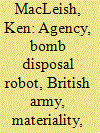

|
|
|
|
|
| Summary/Abstract |
This article posits an analytic of mobilization–demobilization that attends to the instrumentalization and fungibility of military lives as both a primary source of embodied war-related harm and an undertheorized logic of the US war-making apparatus. Based on ethnographic fieldwork among post-9/11 military veterans in a US military community, the article explores mobilization–demobilization across three registers. First, I contrast it with dominant scholarly framings of ‘transition’, ‘reintegration’, and ‘militarization’, terms that analytically compartmentalize war in space and time. Second, I show how mobilization–demobilization drives the uptake and release of military labor and accounts for continuities between war violence and ‘war-like’ domestic political relations in 20th- and 21st-century US military recruiting, welfare, and personnel practices. Finally, I describe the trajectory of one veteran caught up in some elements of mobilization–demobilization, including injury, post-traumatic stress, substance use, and law-breaking, which are structured by the military’s management of his labor. These dynamics demonstrate crucial empirical links between the domestic and global faces of US war-making, and between war and nominally non-war domains.
|
|
|
|
|
|
|
|
|
|
|
|
|
|
|
|
| 2 |
ID:
175117


|
|
|
|
|
| Summary/Abstract |
Under the banner of martial empiricism, we advance a distinctive set of theoretical and methodological commitments for the study of war. Previous efforts to wrestle with this most recalcitrant of phenomena have sought to ground research upon primary definitions or foundational ontologies of war. By contrast, we propose to embrace war’s incessant becoming, making its creativity, mutability and polyvalence central to our enquiry. Leaving behind the interminable quest for its essence, we embrace war as mystery. We draw on a tradition of radical empiricism to devise a conceptual and contextual mode of enquiry that can follow the processes and operations of war wherever they lead us. Moving beyond the instrumental appropriations of strategic thought and the normative strictures typical of critical approaches, martial empiricism calls for an unbounded investigation into the emergent and generative character of war. Framing the accompanying special issue, we outline three domains around which to orient future research: mobilization, design and encounter. Martial empiricism is no idle exercise in philosophical speculation. It holds the promise of a research agenda apposite to the task of fully contending with the momentous possibilities and dangers of war in our time.
|
|
|
|
|
|
|
|
|
|
|
|
|
|
|
|
| 3 |
ID:
175123
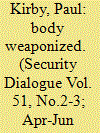

|
|
|
|
|
| Summary/Abstract |
It is today common to argue that rape is a weapon, tool or instrument of warfare. One implication is that armed groups marshal body parts for tactical and strategic ends. In this article, I interrogate this discourse of embodied mobilization to explore how body weaponry has been made intelligible as a medium for sexual violence. First, I show that, despite wide rejection of essentialist models, the penis and penis substitutes continue to occupy a constitutive role in discussions of sexual violence in both political and academic fora, where they are often said to be like weapons, a tendency I term ‘weapon talk’. Second, I trace the image of the body weapon in key threads of feminist theorizing and commentary, to show how the penis has appeared as a ‘basic weapon of force’ in various permutations. Third, I explore the weaponization of the body as it appears in military thought and in the cultural circulation of ideas about the soldiering body in which sexual pleasure and violence are frequently conflated. Building on this foundation, I propose that these literatures collectively describe an uncanny weapon object, and I draw out the significance of this term for feminist security studies and martial empiricism. In short, the uncanny haunts accounts of sexual violence in the collision of sexuality and machinery in the image of a body weapon, in the unsettling designation of sexuality as itself both familiar and dangerous, and in the strange movement of violent bodies across the boundary between wartime and peacetime. A concluding discussion draws out implications and challenges for thinking about embodied violence, advocating renewed attention to the history of weaponization as a fallible and confounding process.
|
|
|
|
|
|
|
|
|
|
|
|
|
|
|
|
| 4 |
ID:
175119
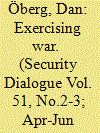

|
|
|
|
|
| Summary/Abstract |
This article analyzes how contemporary military training and exercises shape and reify specific modalities of war. Historically, military training has shifted from being individual- and experience-oriented, towards becoming modelled into exercise environments and practices. Drawing on semi-structured interviews with military officers, exercise controllers, and war-game designers, the article distinguishes between tactical training, characterized by military functions embodied through weapon platforms in a demarcated battlespace, and operational training, characterized by administrative and organizational processes embodied through self-referential staff routines. As military exercises integrate the tactical and operational dimensions into a model for warfare, they serve as blueprints for today’s battles at the same time as they perpetuate a martial viewpoint of the world. As a result, preparations for potential future conflicts constitute a fertile ground for apprehending the becoming of war.
|
|
|
|
|
|
|
|
|
|
|
|
|
|
|
|
| 5 |
ID:
175125
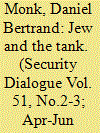

|
|
|
|
|
| Summary/Abstract |
Histories of the Arab–Israeli War of 1967 have advanced a curious commonplace. As they have sought to account for the decisive factors in what they treat as a decisive war, soldiers and interpreters of their arguments have tacitly resorted to what Adolf Loos once referred to as a ‘principle of cladding’, or bekleidungsprinzip, in order to explain the successes of Israel’s armored corps. The bekleidungsprinzip is not a military principle but a dictum of fashion, according to which the renunciation of individual affect in dress is presumed to coincide with the emergence of the qualitative advantages of the modern. With little or no explanation to substantiate the relation between dress and success in armored warfare, histories of this war have instead explained that the causes of a decisive victory may have to be found in the relation between uniforms and technical uniformity. This presupposition possesses an intellectual history, in the course of which war intellectuals repeatedly sought to reconcile what they themselves posed as a contradiction between agency and structure by identifying a proper relation between habit and habitus. Elaborated in a series of doctrinal debates concerning the proper relation of the Jew to the tank in the Israel Defense Forces – and in subsequent interpretations of those disputes – the bekleidung argument is more than a mere curiosity of military history. It points, instead, to a theodicy of conflict according to which a reification of this history’s false premises presents itself to view in repeated images of their transcendence.
|
|
|
|
|
|
|
|
|
|
|
|
|
|
|
|
| 6 |
ID:
175121
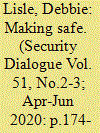

|
|
|
|
|
| Summary/Abstract |
In the Ulster Museum’s new gallery The Troubles and Beyond, the central display showcases a Wheelbarrow bomb disposal robot. This machine was invented by the British Army in Northern Ireland in 1972 and used by officers of the 321 Explosive Ordinance Disposal Squadron (321EOD) to defuse car bombs planted by the Irish Republican Army (IRA). This article offers an alternative history of that machine – a dirtier history – that critically assesses its role during the Troubles. Centrally, the article contests the British Army’s preferred account of this machine as a ‘game-changing’ technological innovation in counterinsurgency, and their understanding of themselves as benign peacekeepers. Rather than figure the Wheelbarrow robot as an unreadable ‘black box’ used instrumentally by the superior human operators of 321EOD, this article seeks to foreground the unruly transfers of agency between the machine and its operators as they tested and experimented in the exceptional colonial laboratory of Northern Ireland. The article further explores the machine’s failures during bomb disposal episodes, the collateral damage that resulted, and the multiple and often unruly reactions of local populations who watched the Wheelbarrow robot at work. Providing a ‘dirty history’ of the Wheelbarrow robot is an effort to demonstrate that war can never be fully cleaned up, either through militarized mythologies of technological innovation or hopeful museum displays.
|
|
|
|
|
|
|
|
|
|
|
|
|
|
|
|
| 7 |
ID:
175124


|
|
|
|
|
| Summary/Abstract |
Fortification calls to mind images of high walls establishing clear lines between inside and outside and immobilizing enemies. However, even the most seemingly inert fortifications rely on subtle forms of mobility and more elaborate spatial relations. This article examines fortification as a technique of power in which warfare, the design of the built environment, and the organization of space are intertwined. Where research on fortification tends to emphasize the symbolic, sovereign aspirations of wall-building, the approach advanced here focuses on the spatial technologies and infrastructural projects of military architecture and engineering that remake space through martial means. The article follows the trajectory within military architecture by which linear fortifications became defense in depth and asks how transformations of ‘depth’ in contemporary warfare have come to integrate more complex, non-linear notions of space and time. By tracing the ways in which the curtain wall of Vauban’s bastion fortress transformed into the radar curtain, I argue that fortification constitutes a ‘becoming war’ in which ‘defensive’ war intensifies organized violence. As such, the concept of fortification proves indispensable for understanding the reinforced boundaries and delineated pathways cutting across the global space of contemporary warfare.
|
|
|
|
|
|
|
|
|
|
|
|
|
|
|
|
| 8 |
ID:
175120
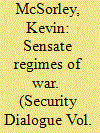

|
|
|
|
|
| Summary/Abstract |
This article explores the fabrication of ‘sensate regimes of war’, concentrating on the typically under-analysed sense of smell. Smell is a sensory mode capable of apprehending potential threat and enmity in ways that are orthogonal to other ways of sensing. Accordingly, the organization and interpretation of olfactory sensation occupies a distinctive place in war. The article details a particular genealogy of martial olfaction, exploring the olfactory capacities of soldiers and their augmentation through various non-human and technological means in specific milieus of combat. It notes how the distinctive affordances of smell have underpinned numerous wartime practices, from tracing improvised explosive devices to militarized manhunting. These developments supplement and trouble ocularcentric accounts of martial sensation and power that concentrate on the increasingly abstracted co-production of vision and violence in wartime. They highlight rather the significance of an alternative ontology of the signature or trace of enmity, and emphasize how in particular warscapes to smell is to kill. The article concludes by arguing that critical inquiry into war would benefit from a broader theorization of all its sensate regimes right across a sensorium that is itself being continuously transformed through war.
|
|
|
|
|
|
|
|
|
|
|
|
|
|
|
|
| 9 |
ID:
175118


|
|
|
|
|
| Summary/Abstract |
In this article, I explore sleep specifically as a weapon of war, as a logistic of war, and as a metaphor for conscience in war. In proposing the capacity to sleep as a measure of the effects of strategies of war, and to recalibrate understandings of intimacy and vulnerability in war, I highlight the distinct effects of war on all its denizens. I make no claim for sameness among their experiences – far from it. And yet, at the same time, I wish to draw attention to what this exploratory essay also conveys, namely, the possibility for a sort of what Judith Butler terms ‘sensate democracy’ in the experience of sleeplessness, exposing a counterintuitive commonality among those deemed friends and enemies. Such a focus brings to the fore that which Simone Weil so powerfully articulated – that violence and force destroy those who wield them and those who are subject to them, potentially reducing each to something less than human, rendering them ‘brothers in the same misery’. Far from facilitating or structuring a relativistic moral equivalence, this potential solidarity provides a form and a measure that, in turn, make way for an analysis of distinct relations of power.
|
|
|
|
|
|
|
|
|
|
|
|
|
|
|
|
| 10 |
ID:
175126
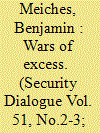

|
|
|
|
|
| Summary/Abstract |
Both classical and critical studies of warfare often comment on the relationship between war and excess. However, even in richly theoretical work, this connection is unanalyzed. This article focuses on the link between excess and war, and seeks to deepen our understanding of why excess reappears so frequently in the study of armed conflict and security studies. Specifically, the article turns to the work of Georges Bataille, an overlooked figure in the critical tradition, who extensively theorized linkages between excess and war. In Bataille’s thought, excess is a key term for explicating the design, mobilization, and transformation of war. Moreover, Bataille sees the exposure to excess as playing a key part in social attachments to violence and armed conflict. The article unpacks how Bataille theorizes excess and applies his insights to the context of precision warfare. Using the case of the accident in the era of precision war, it reveals how Bataille anticipates many of the dynamics that structure late warfare through his understanding of excess. The article concludes by describing how Bataille’s vision of excess would challenge critical war and security studies literatures in relation to the problems of war experience, relationships to death, and scholarship.
|
|
|
|
|
|
|
|
|
|
|
|
|
|
|
|
|
|
|
|
|